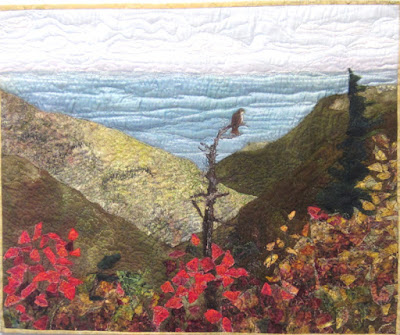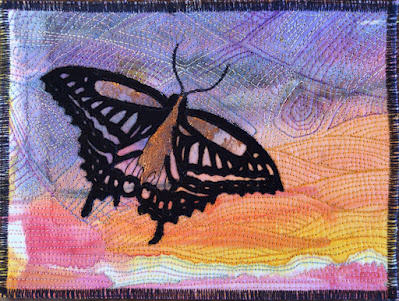 |
Geometrics 29: Power Lines
Susan Lilley, 2021 30"x30" |
Susan Lilley’s solo show, Geometrics (bound and unbound) opens October 8 at the Chester Art Center. The exhibition is of a series of work created over the last two years.
Now a resident of Lunenburg County, Nova Scotia, Susan was born in Quebec amidst a family of artists. Although her art classes began at a very early age, it was only after a 30 year career in public health that she returned to art-making.
In 2010, Susan completed the City and Guilds of London Level 3 Certificate in Design and Craft. She is currently an active member of the Textile Artists Collective, the Lunenburg Art Society and SAQA Atlantic Canada.
Susan has exhibited her work in numerous local, regional, national and international exhibitions. Geometrics (bound and unbound) is her third solo show.
 |
| Geometrics 2 Susan Lilley 2019 12"x12" |
Q: Susan, how would you describe your work?
My work is non-representational. I use strong colours and my own hand-dyed, repurposed fabrics, often featuring shibori or surface-design techniques.
In my latest collection, Geometrics, all 30+ pieces were composed of strips of brightly-coloured fabric over-dyed in black to create bold, repeated, geometric patterns. I prepared the cotton for the black dyebath using a shibori technique called itajime, which involves folding the fabric, adding resists and using clamps to hold it all together, thus preventing dye penetration and creating the pattern.
Q: What prompted you to choose this particular technique for your series?
Itajime both fascinates and challenges me. I’m drawn to it for several reasons: the “glow” effect of the blurred dye lines, the contrast of order with imperfection, and my inability to control the outcomes. Relinquishing control in this way, I, myself, am unbound.
Traditionally, itajime involves only a single dye bath, often indigo or brown, leaving white patterning. I spent a couple of years previously experimenting with a more complex approach, layering colour over colour and pattern over pattern with multiple rounds of folding and dyeing. While I was able to make a few exciting pieces, I was more often disappointed with my results.
This current series began as a way to become more skilled at itajime by simplifying my process: making many small studies, using narrow strips and a single colour (+black). I was also hoping to become more fluid and relaxed in my work and to develop my own style of itajime.
 |
| Geometrics 19 2021 12"x12" |
Q: Had you worked in series before, and if so, how was this series different for you?In the past, I generally made a few pieces expressing the same idea in different ways, but this is the first time I've intentionally set out to create a series. My plan at the outset was to make 20-25 small (12”x12”) studies, followed by a few larger pieces, an idea suggested by Cape Breton artist and friend Helene Blanchet.
Making so many small studies, guided by a few simple rules, was surprisingly both liberating and addictive. I approached each new piece knowing it didn’t have to be perfect, so I could relax and let go. And each completed study left me with a head full of “what ifs”, compelling me to go on to make another.
 |
| Geometrics 22 Susan Lilley 2021 12"x12" |
Q: Do you see this body of work as a departure from your earlier work?
I think this collection builds quite naturally on my previous work. The departure, in my mind, is the long-term commitment to developing a specific idea. During this two-year journey I have surpassed my initial goals and discovered my own unique approach to itajime.
Q: Do you have plans for your work for the coming year?
Itajime still fascinates me. I’ve not yet decided what my next challenge will be but I expect to use a similar, experimental approach, probably involving multiple colours and dyebaths.
 |
| Geometrics 28: Spirit Ways 30"x30" 2021 |
Q: In addition to the show in Chester, where else can your work be seen?
I’m hoping to hang some of this work in the Bridgewater branch of the South Shore Public Libraries next winter. I generally have a piece or two hanging at the Lunenburg Art Gallery, changing every month from May to October. I also have two pieces in the SAQA Atlantic juried show, Commotions, which will be travelling around Atlantic Canada in the next year. And for those outside the region, I’ve recently taken to sharing my work on Instagram.
 |
| Geometrics 30: Making Do 2021 34"x39" |
Susan's show, Geometrics (bound and unbound), opens with a reception from 5-7pm on Friday October 8th at the Chester Art Centre in Chester NS. The show runs until October 28th, however, gallery hours vary considerably from one day to the next:
October 9,10,15,17,21,28 - Gallery open from 10am-4pm
October 14,16,20,22,23,24,27 - Gallery open from 5-7pm
The Gallery may be open at other times by chance or appointment. Contact Chester Art Centre at 902-275-5789 or info@chesterartcentre.ca before setting out.

















































